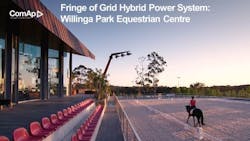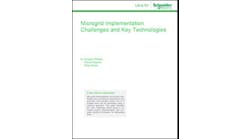When bush fires swept the south coast of New South Wales in Australia last year, an equestrian center showed why it’s good to have a neighbor with a microgrid.
Willinga Park, an equestrian property that spans 2,000 acres on two national parks, became a safe haven for local residents’ cattle and horses in December, and its islanded microgrid provided power to the nearby town of Bawley Point.
The owner used private firefighting resources to keep the fire off his property, which ensured the microgrid remained intact and that the animals were safe. It also allowed firefighters to focus on other properties threatened by fire.
Photo courtesy ComAp
“The grid was offline from the fires. Those fires were massive, millions of hectares of bush and national forest went up in flames, and one of the fires was on the doorstep of the property,” said Chris Pye, Australia engineering and innovation manager for ComAp Asia Pacific, which supplied the microgrid controls. “It was a place to bring cattle and livestock. It was also a place that provided power.”
By January 2021, more than 27.2 million acres of bush, forest and parks across Australia had burned.
In lieu of paying for utility upgrades
The equestrian center is located on the Meroo and Murramarang national parks and houses 650 cattle, 120 horses and 30 staff.
An 800-kW solar system, a 500 kW/2.2 MWh Tesla battery storage system and three diesel generators capable of producing about 3 MW make up the behind-the-meter microgrid, said Pye. It also includes an energy management system from ComAp.
The microgrid, funded by Willinga Park, replaced the need to bolster the utility’s distribution system to serve Willinga Park. The property is at the grid edge and without the microgrid Snow would have had to pay the local utility, Endeavour Energy, for distribution grid upgrades.
Demand spikes during equestrian events
The equestrian center, which includes a covered arena, three outdoor arenas, a show jumping field, 200 event stables, a vet room, accommodations and catering facilities, requires about 500 kW when there are no special events taking place. But it needs up to 10 times as much power when the park is running events, Pye said.
For example, in May 2019, during the World Championship Gold Buckle Campdraft, 4,000 people entered the facility to watch the campdrafting event, an Australian sport that involves horses and riders working cattle.
The site’s three grid connections were unable to meet the needs of the facility during events that attract so many visitors. What’s more, the park is located on the fringe of the grid, and it was difficult to regulate and maintain power quality in the area during events.
That’s where the microgrid comes in.
“This is a perfect example of a microgrid that deals with constrained transmission and distribution and deals with resilience issues, in this case, fires. What’s been done in Australia is applicable anywhere the grid is stressed or there are grid concerns,” said Bill Becker, renewable energy sales manager for ComAp Americas.
Microgrid capable of power exports
The microgrid is connected to utility Endeavour Energy and can export available power to the grid. And the battery provides stability for the local network. The park can use the microgrid to meet and exceed its own energy needs — about 500 kW — during normal, nonevent operations, said Pye.
Diesel generators only operate during events when there’s not enough solar or utility power available.
“The diesel only operates five or six days a year. Beyond that, it’s a net zero or a net negative producer of carbon. The rest of the time, the park is basically exporting solar into the grid and displacing coal fired plants,” said Pye.
The park’s microgrid provides 500 kW of controlled solar and 300 kW of uncontrolled solar. Controlling solar means ComAp controls ensure the solar doesn’t stress the grid.
“Sometimes we don’t want to push more power into the grid,” said Pye. “We can moderate how much is produced.”
The 300 kW of solar that is uncontrolled flows freely.
Courtesy of ComAP
With this project, ComAp learned that the three connection points to the utility posed some challenges. If the company were to do it again, it would recommend that the park install its own medium voltage infrastructure on the property, with a single point of connection.
This move to a single point of connection would be important if Endeavour Energy added export constraints. In that case, it would be difficult to figure out where to constrain the solar output with three points of connection, Pye explained. “We would have to upgrade the transformer to try and balance it out better so we would be pushing equally at the three connection points,” he said.
Bush fires spurring microgrids in Australia
Bush fires in Australia have prompted efforts to install more microgrids. For example, Australia’s principal energy rule maker has set the stage for network operators to cut network ties to remote customers, instead delivering stand-alone power systems based around solar and batteries that will yield savings to all consumers.
“The Willinga Park microgrid’s ability to assist with community network stability and provide energy security to the owner is a great example of the benefits microgrids can deliver,” said Pye. “This is the best example of why this project has been such a success,” he added.
Learn more about microgrids in Australia — and worldwide — at Microgrid 2021: The World Awakens to Microgrids, a free virtual conference designed to educate those considering microgrids for their operations.








